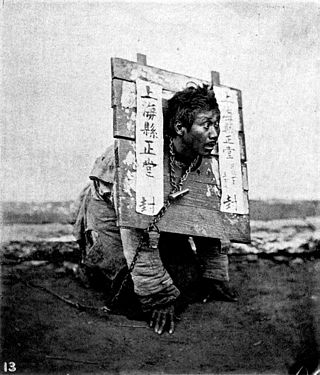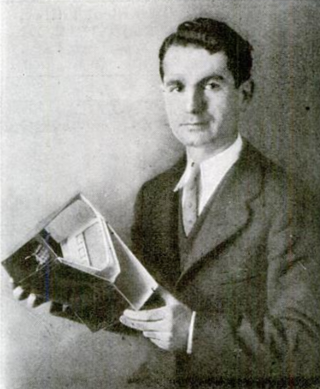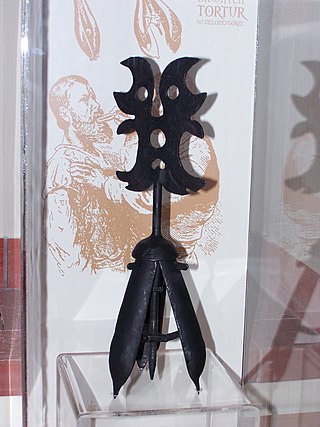Related Research Articles

Bangor is a city in and the county seat of Penobscot County, Maine, United States. The city proper has a population of 31,753, making it the state's third-most populous city, behind Portland (68,408) and Lewiston (37,121). Bangor is known as the "Queen City."

The pillory is a device made of a wooden or metal framework erected on a post, with holes for securing the head and hands, used during the medieval and renaissance periods for punishment by public humiliation and often further physical abuse. The pillory is related to the stocks.

Public humiliation or public shaming is a form of punishment whose main feature is dishonoring or disgracing a person, usually an offender or a prisoner, especially in a public place. It was regularly used as a form of judicially sanctioned punishment in previous centuries, and is still practiced by different means in the modern era.

Cock and ball torture (CBT) is a sexual activity involving the application of pain or constriction to the male genitals. This may involve directly painful activities, such as genital piercing, wax play, genital spanking, squeezing, ball-busting, genital flogging, urethral play, tickle torture, erotic electrostimulation, kneeing or kicking. The recipient of such activities may receive direct physical pleasure via masochism, or emotional pleasure through erotic humiliation, or knowledge that the play is pleasing to a sadistic dominant. Many of these practices carry significant health risks.
Water torture encompasses a variety of techniques using water to inflict physical or psychological harm on a victim as a form of torture or execution.

A cangue, in Chinese referred to as a jia or tcha is a device that was used for public humiliation and corporal punishment in East Asia and some other parts of Southeast Asia until the early years of the twentieth century. It was also occasionally used for or during torture. Because it restricted a person's movements, it was common for people wearing cangues to starve to death as they were unable to feed themselves.

George Frederick Root was a romantic American composer, who found particular fame during the American Civil War, with songs such as "Tramp! Tramp! Tramp!" and "The Battle Cry of Freedom". He is regarded as the first American to compose a secular cantata.

Luther George Simjian was an Armenian-American inventor and entrepreneur. A prolific and professional inventor, he held over 200 patents, mostly related to optics and electronics. His most significant inventions were a pioneering flight simulator, arguably the first ATM and improvement to the teleprompter.
There are cases, both documented and alleged, that involve the usage of torture by members of the United States government, military, law enforcement agencies, intelligence agencies, health care services, and other public organizations both in and out of the country.

Helen Augusta Blanchard was an American inventor who received 28 patents between 1873 and 1915. She was known for her numerous inventions dealing with sewing machines and sewing technology.

Breast torture is a BDSM activity in which sexual stimulation is provided through the intentional application of physical pain or constriction to the breasts, areolae or nipples of a submissive. It is a popular activity among the kink community. The recipient of such activities may wish to receive them as a result of masochism or they may have a desire to please a dominant who is sadistic. Those involved may also be motivated by breast fetishism. Mild breast torture such as light impact play on the breasts is also occasionally used outside of the BDSM context to provide stimulation and pleasure during conventional sex.

The pear of anguish, also known as choke pear or mouth pear, is a device of disputed use invented in the early modern period. The mechanism consists of a pear-shaped metal body divided into spoon-like segments that can be spread apart with a spring or by turning a key. Its proposed functionality as a torture device is to be variously inserted into the mouth, rectum, or vagina, and then expanded to gag or mutilate the victim; its historical use as a torture device is controversial.

Norman Lee Cahners (1914–1986) was a major American publisher and philanthropist. The Cahners Publishing Company, which he founded in 1960, had grown into the largest U.S. publisher of trade or business magazines at the time of Cahner's death, three weeks before he was scheduled to retire. Cahners Publishing survived into the early 2000s as Cahners Business Information, a division of the British and Dutch-based Reed Elsevier publishing empire. The company was renamed Reed Business Information (U.S) in 2002, and its headquarters moved from Boston to New York.

The United States provided many inventions in the time from the Colonial Period to the Gilded Age, which were achieved by inventors who were either native-born or naturalized citizens of the United States. Copyright protection secures a person's right to his or her first-to-invent claim of the original invention in question, highlighted in Article I, Section 8, Clause 8 of the United States Constitution, which gives the following enumerated power to the United States Congress:
To promote the Progress of Science and useful Arts, by securing for limited Times to Authors and Inventors the exclusive Right to their respective Writings and Discoveries.
David Slagger is a Maliseet politician in Maine. Slagger served as a member of the Maine House of Representatives, representing the newly recognized Maliseet Tribe. Slagger was sworn-in as the appointed representative to the House of Representatives on January 4, 2012. He held the seat temporarily until a tribal election could be conducted to elect a Maliseet Tribal Representative, which the Maliseet Tribe then did on December 22, 2012 when tribal members elected Henry John Bear as their first elected Tribal Representative to the Maine House of Representatives. Slagger did not seek another term as Maliseet representative.
The iron bit, also referred to as a gag, was used by enslavers and overseers as a form of punishment on slaves in the Southern United States. The bit, sometimes depicted as the scold's bridle, uses similar mechanics to that of the common horse bit. The scolds bridle however, is almost always associated with its use on women in the early 17th century and there are very few accounts of the device as a method of torture against black slaves under that particular name. As opposed to the whip, the iron bit lacks the historic, social, and literary symbolic fame that would make information on the use of the iron bit as accessible. Its use throughout history has warranted some attention though, mostly from literary texts. Even earlier, slave narratives and publications of newspapers and magazines from the 18th century on give evidence of this device being used to torture and punish slaves.
Patricia M. Collins was an American civic leader and politician who served as the mayor of Caribou, Maine from 1981 to 1982. She has chaired numerous local and state boards and organizations, including the Caribou School Board, the Maine Committee for Judicial Responsibility and Disability, Catholic Charities Maine, and the University of Maine Board of Trustees. She was inducted into the Maine Women's Hall of Fame in 2005.

Mildred Brown "Brownie" Schrumpf was an American home economist, food educator, and author. Named the "Unofficial Ambassador of Good Eating" by the Maine Department of Agriculture, she wrote a weekly food column for the Bangor Daily News from 1951 to 1994 promoting traditional Maine recipes. She was the main proponent of the claim that the chocolate brownie was invented in Bangor. She was inducted into the Maine Women's Hall of Fame in 1997.
Patricia E. "Pat" Ryan is a human rights and women's rights advocate. She served as executive director of the Maine Human Rights Commission, a state agency tasked with enforcement of Maine's anti-discrimination laws, for over three decades. Prior to that, she chaired the Maine Commission for Women and the Maine State Personnel Board. She was a co-founder of the Maine Women's Lobby. She was inducted into the Maine Women's Hall of Fame in 2014.
References
- ↑ "Vintage instrument of humiliation, 'tramp chair' returns to Oakland". Press Herald. June 10, 2017. Retrieved November 11, 2023.
- ↑ "The Tramp Chair". American Police Hall of Fame. Archived from the original on 19 August 2003.
- ↑ Curtis, Abigail (2015-05-23). "Tramp chair on display at Searsport museum". Bangor Daily News. Retrieved 2022-09-05.